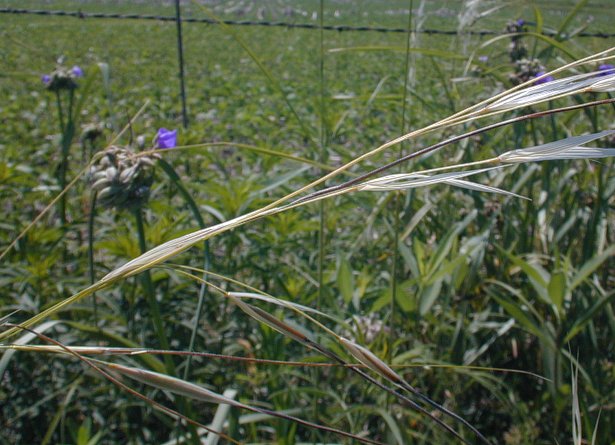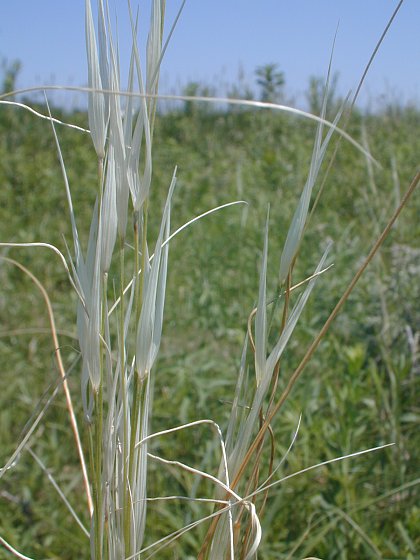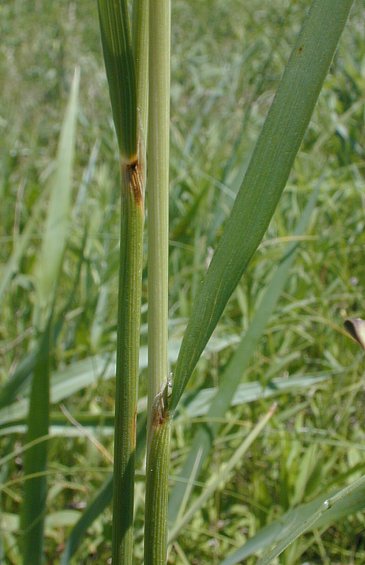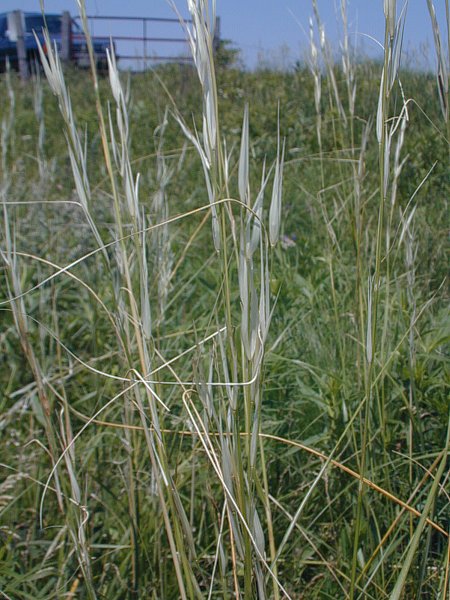Description: This perennial grass forms low basal leaves and small tufts of leafy culms about 2½–3½' tall. The culms are mostly erect, but they usually lean over to one side after the blooming period because of the heavy weight of the developing spikelets. The culms are terete, glabrous, and initially pale green; after the blooming period, they become tan or straw-colored. Several alternate leaves occur along each culm. The leaf blades are up to 12" long and 5 mm. across; they are pale to medium green and either flat or rolled upward along their margins. The leaf sheaths are longitudinally veined and initially pale to medium green. After the blooming period, they become yellowish green to pale brown. Both the leaf blades and sheaths are glabrous, or nearly so. The basal leaves are similar to the alternate leaves, except they are semi-evergreen and their blades are a little longer than the blades of the latter. The ligules are white-membranous.

Each culm terminates in a little-branched panicle of spikelets about 6-10" long that leans to one side. Each lateral branch of the panicle bears 1-2 spikelets. The bodies of the spikelets are a mixture of greenish brown and greenish white, linear-lanceoloid in shape, and 1¼–1½" (30-40 mm.) in length (excluding the awns). A spikelet consists of 2 glumes, an awned lemma, a palea, and a perfect floret. The glumes are 1¼–1½" long, linear-lanceolate in shape, white-membranous, and convex along their outer surfaces; each glume has 5-7 longitudinal veins. The lemma is ¾–1" long (excluding its awn), linear-lanceolate in shape, brown, and convex along its outer surface; it wraps around the palea and ovary of the floret. The outer surface of the lemma is mostly pubescent, although it becomes hairy toward the bottom.

The sharp awn of the lemma is 3-8" long. This awn is initially straight, but it later bends at a sharp angle (usually at two locations); the lower portion of the awn is spirally twisted. The floret of each lemma has 3 anthers, 2 stigmas, and an ovary. The blooming period occurs from late spring to early summer, lasting about 1-2 weeks. The florets are cross-pollinated by the wind. When the grains become mature, the awned lemmas detach from the spikelets and fall to the ground, while the glumes remain attached to the branches of the panicle. Over time, the twisting motion of the contorted awn can drill the lemma with its grain into the ground. The root system consists of a tuft of deep fibrous roots.

Cultivation:
The preference is full sun, mesic to dry conditions, and sandy or
gravelly soil. However, fertile loamy soil and a little shade are also
tolerated. Most growth and development occurs during the spring and
early summer; this is a cool-season grass with a C3 metabolism.
Range & Habitat:
The native Porcupine Grass is occasional in the northern half of
Illinois and
largely absent from the southern half of the state (see Distribution
Map). Habitats include mesic to dry black soil prairies, sand
prairies,
gravel prairies, dolomite prairies, hill prairies, upland savannas and
sandy savannas, pastures, roadsides, and areas along railroads.
Porcupine Grass is a typical prairie grass of the Northern Plains
region of the United States (including both
tall-grass and mixed-grass prairies).

Faunal Associations: The leafhopper Commellus colon is a specialist feeder of Porcupine Grass; another leafhopper, Hecalus viridis, may feed on this grass as well (DeLong, 1948; Haarstad, 2002). Because this grass is often found in dry open prairie, its foliage is occasionally eaten by various species of grasshoppers that prefer this kind of habitat, including Arphia conspersa (Speckle-winged Grasshopper) and Chloealtis abdominalis (Thomas' Broad-winged Grasshopper); see Vickery & Kevan (1985). The Franklin Ground Squirrel and Thirteen-Lined Ground Squirrel eat the seeds of Needle grasses (Hesperostipa spp.); see Martin et al. (1951/1961). The young foliage is palatable to various hoofed mammalian herbivores, including horses, cattle, and bison. However, the long awns of mature plants can injure the mouth parts of these animals or pierce their skin. The awns can become caught in the wool of sheep or bison and transported considerable distances as a result.

Photographic
Location:
The Shortline Prairie in Champaign County, Illinois.
Comments:
Porcupine Grass (Hesperostipa
spartea) has the longest awned lemmas of
any grass species in Illinois. After releasing their awned lemmas to
the ground, the culms of this grass become more erect and assume a
somewhat ghostly appearance because of the long white-membranous
glumes. The only other grass species that is similar, Needle-and-Thread
(Hesperostipa
comata), is slightly smaller in stature
and it has shorter glumes (up to 1" in length), shorter lemmas (up to
½" in length), and
slightly shorter awns (up to 6" in length). In the more western and
drier areas of the Northern Plains region of the United States, this
species largely replaces Porcupine Grass. While
Needle-and-Thread has been found in northern Illinois, it is a rare
plant within the state. Alternative scientific names of
Needle-and-Thread and Porcupine Grass
are Stipa comata and Stipa spartea,
respectively.